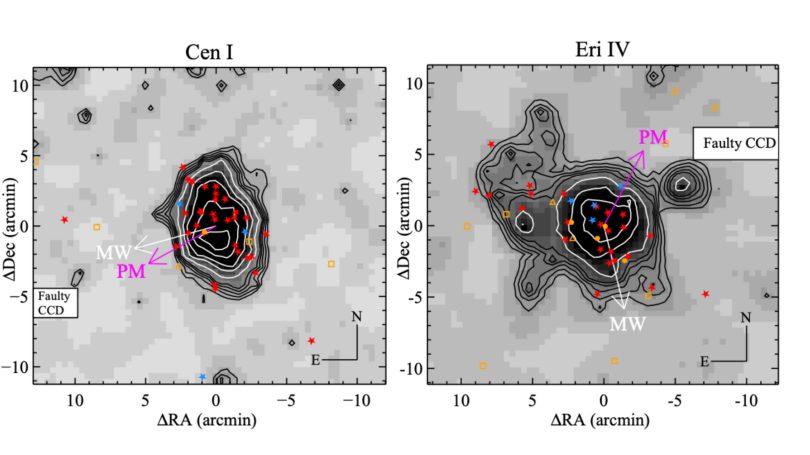

Graduate student Quinn Casey leads one of the first detailed observations of two ultra-faint galaxies near the Milky Way. His research, 'Deep Photometric Observations of Ultrafaint Milky Way Satellites Centaurus I and Eridanus IV', clarifies the two galaxies' structures and provides new understandings of their evolution. The Astrophysical Journal published Casey's work, which is also his first paper as a lead author, on May 7th, 2025.
Astronomers at Dartmouth College and around the world conducted deep photometric observations of two recently discovered ultra-faint galaxies orbiting the Milky Way, Centaurus I (Cen I) and Eridanus IV (Eri IV). The study, led by graduate student Quinn Casey and Professor Burçin Mutlu-Pakdil, utilized the powerful Magellan Clay telescope in Chile to reveal new details about the galaxies' nature, structure, and distance. The team's observations probed much fainter stars than previous research, and offer fresh insights into these enigmatic celestial companions.
Ultra-faint dwarf galaxies (UFDs) are among the smallest, dimmest, and most ancient galaxies known. Their luminosities are typically several thousand times that of our Sun, and sometimes as faint as just a few hundred solar luminosities. Comparatively speaking, the Milky Way has roughly fifteen billion solar luminosities and a radius 60 times larger than the average UFD. The two UFDs in Casey's research, Cen I and Eri IV, are bound to the Milky Way's gravitational pull and act as satellites to our galaxy. Despite their small size, UFDs offer vitally important insights into galaxy formation in the early Universe.

Despite being more than 200,000 light years away, Casey and Mutlu-Pakdil were able to determine the UFDs' radii, ellipticities, and luminosities to a much higher precision than previous observations. They found that the stars composing these UFDs are approximately 13 billion years old - forming shortly after the Universe began. The team also identified new potential member stars for follow-up studies of either UFD.
Interestingly, Casey's findings both confirm and contradict previous assessments of Cen I and Eri IV's morphologies documented in earlier studies. Gravitational - or tidal - interactions between galaxies can stretch the typically concentric shape - or morphology - of a galaxy. The two UFD's discovery imaging data hinted at extended stellar features surrounding both galaxies, suggesting some sort of dynamic interaction with another galaxy. A follow-up spectroscopic analysis suggested that, if these extended features were real, they were not caused by dynamical interactions.
Casey found that Cen I exhibits a well-defined morphology lacking any extended features which suggests dynamic stability. Eri IV, on the other hand, hosts a peculiar stellar structure situated northeast of the system's center. This elongated structure shares similar stellar properties with Eri IV, indicating the stars within this extension likely originated from Eri IV.
"The stellar morphology of Eri IV, in particular, is incredibly fascinating. The dynamics suggest that a typical tidal interaction did not produce the extension, so we get to invoke more exotic mechanisms to understand the nature of the system". -Quinn Casey
One potential explanation is that the extended feature originated from a tidal interaction with the Milky Way approximately 2 billion years ago, but its stellar velocities don't support this idea. Further explanations include a stellar halo resulting from a merger very early in the Universe, a sub-satellite of Eri IV, or a starless dark matter halo capturing stars from their host. While the exact origin of the extended component remains unknown, Casey's study proves its existence to high significance and offers exciting and novel explanations for its presence.
Clearly defined morphologies are not only useful to understand interactions between galaxies, but also to better understand dark matter. UFDs are the most dark-matter-dominated galaxies in existence. Their dynamics offer unique constraints of the nature, distribution, and behavior of dark matter on the smallest scales. Professor Burçin Mutlu-Pakdil offers the following connection between morphological data and dark matter theory; "Much of our understanding of ultra-faint dwarf galaxies and their connection to dark matter depends on the assumption that they are in dynamical equilibrium. However, if these galaxies experience tidal effects from their host galaxies and this is not properly accounted for, estimates of their dark matter content may be incorrect, leading to significant inaccuracies in theoretical models."
Casey's detailed research of Cen I and Eri IV adds to astronomer's growing inventory of UFD galaxies orbiting the Milky Way. His work will help refine models of small-scale galaxy structure formation and evolution, and clarify the role faint galaxies play in the cosmic ecosystem. Casey is excited to see where in the Universe his research will take him next during his fourth year of graduate school and beyond. You can read Casey's full publication here.